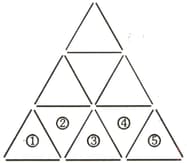Arithmetic Progressions
Arithmetic Progressions: Overview
This topic covers concepts, such as, Arithmetic Progression (A.P.), Common Difference of an A.P., Mean & Arithmetic Mean (A.M.) of n Numbers etc.
Important Questions on Arithmetic Progressions
How many three-digit numbers are divisible by $6$ in all?
How many natural numbers are there between and which are exactly divisible by ?
For each positive integer , let denote the increasing arithmetic sequence of integers whose first term is and whose common difference is . For example, is the sequence . Find the number of values of for which contain the term .
If are positive and are in and roots of the quadratic equation are real then
If the term of an arithmetic series is and the term is , then find the sum of first terms.
If the term of an arithmetic series is and the term is , then find the value of term
If the term of an arithmetic series is and the term is , then find the value of term
If the term of an arithmetic series is and the term is , then find the value of first term
The number of positive integers which satisfy the condition , where is greatest integer functions
The number of -tuples of positive integers such that
I. are the measures of angles of a convex pentagon in degrees
II.
III. are in arithmetic progression, is
The sum of consecutive terms of an arithmetic progression consisting of integers is . Then, a possible value of is
What is the term of this A.P series
what is the term of this A,P. series
What is the term of the A.P.
The first four terms of an arithmetic sequence are and . What is the sum of digits of the term of the sequence?
A large equilateral triangle is constructed by using toothpicks to create rows of small equilateral triangles. For example, in the figure we have rows of small congruent equilateral triangles, with small triangles in the base row. Total number of toothpicks would be needed to construct a large equilateral triangle if the base row of the triangle consists of small equilateral triangles. Then find the sum of all digits of

A circle with area is contained in the interior of a larger circle with area . If the radius of the larger circle is , and if is an arithmetic progression, then the radius of the smaller circle is
If the sum of all five numbers which are in Arithmetic Progression is and the product of the second and fourth term is . Find the fifth term of the Arithmetic Progression.
The interior angles of a polygon are all obtuse and are in A.P. If the smallest angle is and common difference of this A.P. is then the number of sides of the polygon is___________
If and are in Arithmetic Progression, then the value of is _________.
